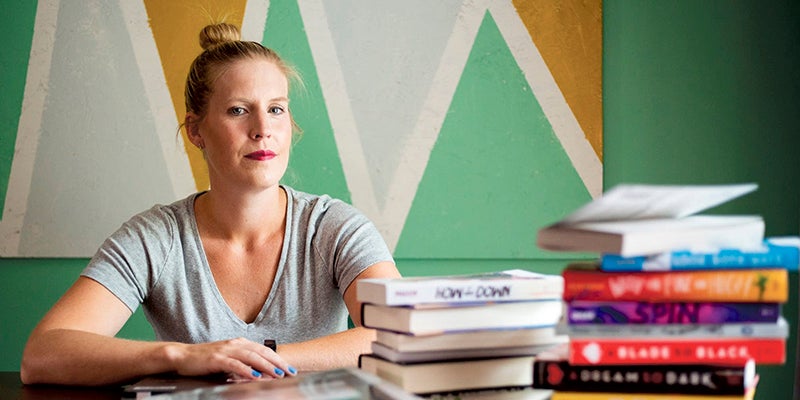Many Minnesota teachers wary of returning to the classroom
Published 7:01 am Sunday, August 9, 2020

- Eighth grade language arts teacher Karin Hogen sits in her White Bear Lake, Minn., home with books she’ll use to teach her classes in fall on Wednesday. As more school districts in Minnesota decide how to go back to school this fall, many teachers like Hogen feel uneasy about returning to the classroom in the middle of a pandemic. Evan Frost/MPR News
|
Getting your Trinity Audio player ready...
|
By Riham Feshir
In a typical school year, Karin Hogen would be back in school at the end of the summer, setting up her classroom with posters and making it as nice as possible for the start of the fall.
“That first week of school is always such a rush because you meet all your kids and just start to build those relationships,” the middle school language arts teacher said.
But this year, she’s overcome with anxiety about returning to that classroom — because her suburban school district plans to start the year with a hybrid model.
Even though that would cut the number of students in her building at any given time by half, it’s still not enough to make her feel safe.
“I became a teacher so that I can be with my students,” she said. “I love my job, absolutely hands down love it. But I can’t love my job and I can’t teach my students if we’re deathly afraid of making each other sick.”
As more school districts in the state decide how to go back to school this fall, many teachers feel uneasy about returning to the classroom in the middle of a pandemic. Educators say the governor’s back-to-school plan allows for hundreds of students to be back in any given school building — a decision, they say, that makes it tricky to implement measures to keep them safe.
A study in the Journal of the American Medical Association published last week found that children present with milder symptoms than adults, but it warns that young children can potentially spread the virus in the general population. A recently published study suggests older children can spread the virus just as much as adults.
The state’s guidance gives each district the flexibility to decide based on COVID-19 data in their area.
But teachers say — other safety measures are just as important.
School administrators are still working out the logistics to figure out exactly how to keep students from congregating in the hallways or the lunchroom, and how to get kids to keep their masks on and maintain the cleanliness of classrooms.
Ted Conover teaches middle school English for the Wrenshall School District in northern Minnesota. His area hasn’t been hit hard by COVID-19, with 132 confirmed cases and no deaths, according to the Department of Health. But he worries that the disease will spread later in the school year.
“There was just a community night a few days ago where there was people congregated in large group in a city park and there was a bouncy castle for kids to play in,” he said. “That’s kind of alarming to see. I don’t think people in this community are necessarily taking it seriously.”
He’s not alone in his concerns. A national poll from NPR and Ipsos released this week found that 82 percent of K-12 teachers say they are worried about in-person teaching this fall, and two-thirds prefer to teach primarily remotely.
Minnesota’s plan gives families the choice to keep their students home and opt for remote learning. But teachers and other school employees don’t appear to have as much flexibility.
Gov. Tim Walz’s executive order says teachers can work from home “to the extent possible” if their or their family members’ health is at risk. Department of Education officials say schools should follow their own HR and contract procedures for when employees are requesting accommodation for disability.
Denise Specht, the president of the state’s largest teachers union, Education Minnesota, said the state guidance leaves a lot up for interpretation. She said districts will have to abide by federal laws like the Family Medical Leave Act.
“There is a lot of apprehension and anxiety around whether the buildings are going to be ready,” she said. “No one should be forced to work in an environment that puts them and their family in unnecessary risk for getting sick with COVID-19.”
Still, seventh grade math teacher Waleid Hassan is feeling confident that a hybrid model is going to work better than distance learning last spring.
At his school in Brooklyn Park, he expects to have around 13 students at a time this fall, which will make it easier for him to social distance and enforce a mask policy.
“I really missed the structure that school provided, not just for the students, for myself,” he said. “It was really hard to get a routine going. A lot of students felt that way as well. I started to miss the energy I got from my students.”
As school districts across the state finalize their plans, Hogen, the language arts teacher, said so much of her energy has been focused on the uncertainty of it all. She can’t help but think about the role a hybrid model could play in spreading COVID-19.
“I can’t have a classroom community and teach kids effectively if one of us we know is sitting in the hospital dying,” she said. “It’s impossible.”





